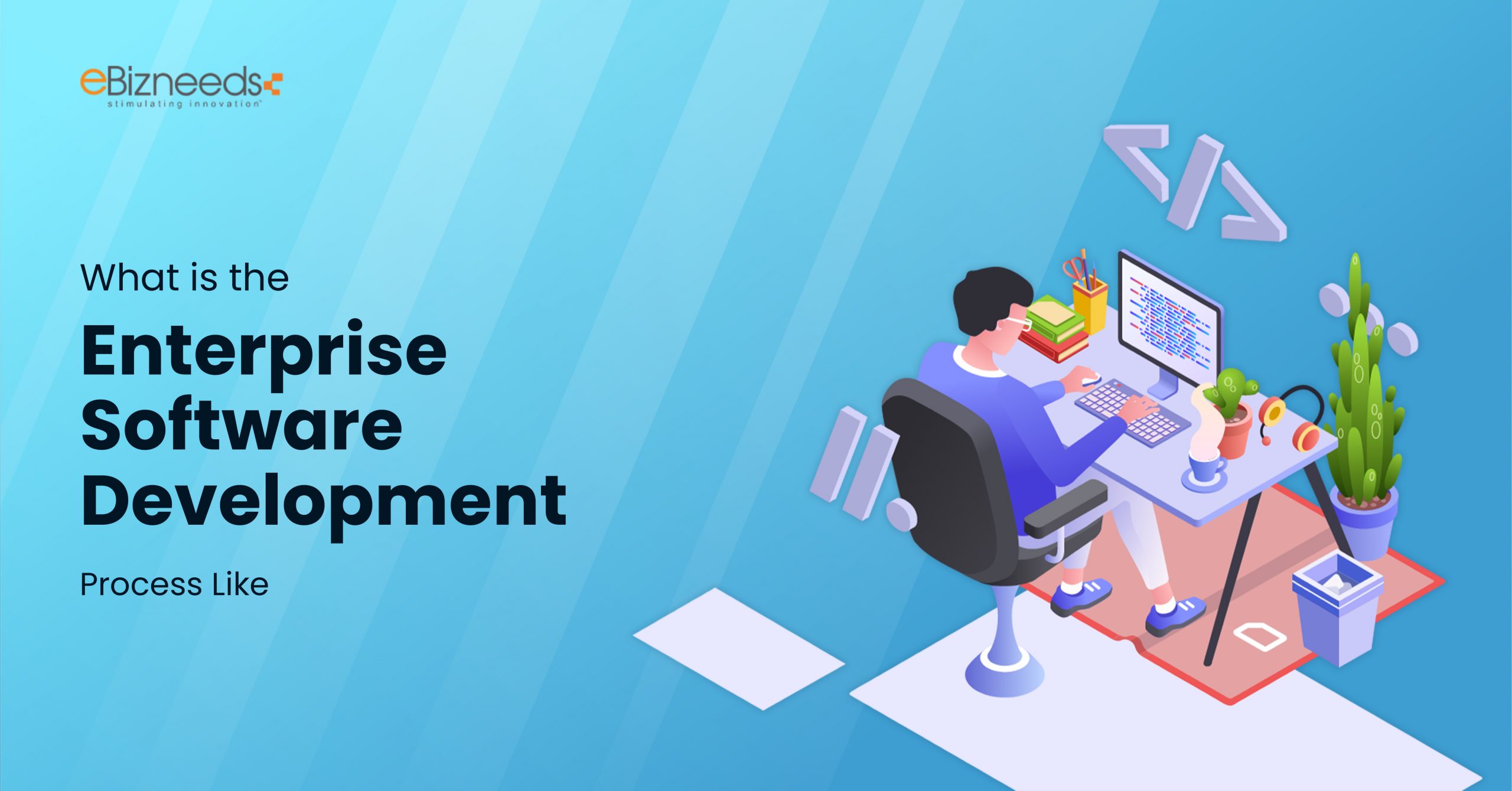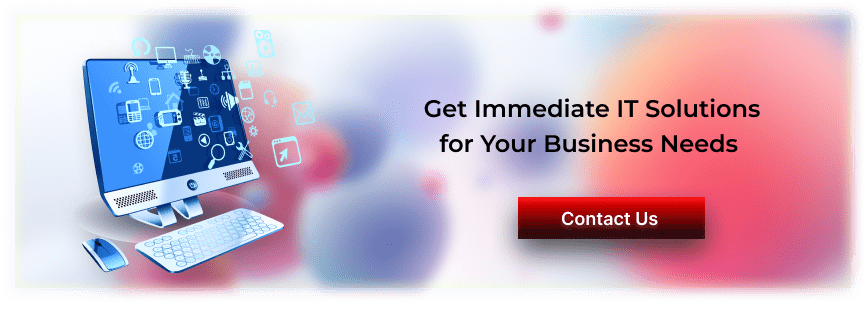Last updated on December 29th, 2023 at 05:29 am
Navigating the realm of enterprise software development process demands insight and strategy. This comprehensive guide unveils the intricate stages and pivotal considerations that shape the creation of sophisticated business solutions.
From conceptualization and design to coding, testing, deployment, and maintenance, the journey through enterprise software development involves meticulous planning and coordination.
Explore the key methodologies, tools, and best practices that underpin successful development endeavors, empowering organizations to craft robust, scalable, and tailored software solutions that elevate operational efficiency and drive growth in the modern business landscape. Embark on this illuminating expedition into the world of enterprise software development process.
What is Enterprise Software Application?
An Enterprise Software Application, often referred to as Enterprise Software, is a specialized type of software designed to meet the specific needs and requirements of larger organizations or enterprises. It is developed to support and streamline various complex business processes and operations within an organization.
Enterprise software applications are typically comprehensive and integrated solutions that address multiple functions, departments, and workflows. They may encompass areas such as customer relationship management (CRM), enterprise resource planning (ERP), human resources management (HRM), supply chain management (SCM), financial management, and more.
These applications are characterized by their scalability, security, and ability to handle large amounts of data and users. They often include features such as data analytics, reporting, automation, and customization options to align with the organization’s unique processes.
Overall, enterprise software applications play a crucial role in enhancing operational efficiency, data management, decision-making, and collaboration within complex business environments.
The Essential Phases of Enterprise Software Development
An enterprise software application must be able to store, display, and manage large amounts of complex data. In addition, the work program should support or automate work processes based on this information. These applications must be scalable, robust in terms of functionality and data analysis capabilities, centrally managed, and interoperable with other software and hardware.
Some of the most common features of enterprise applications are the ability to process orders, software skills, customers, and so on. The purpose of a program will depend on the industry and a particular company, but there are still some constants you can expect when you begin the process of developing enterprise software.
The Planning Phase
Planning is one of the most important steps in business software development. Before you begin, come up with a plan that includes project plans, timelines, timelines, costs estimates, budgets, and project requirements.
Project Planning: The project plan will help define the development tools, programming language, and platform to complement the program approach.
Schedules and Timelines: Software improvement requires the hour of experienced engineers, creators, and inventive craftsmen. Ensure you set practical cutoff times and accept the advancement group. This will tell partners when to anticipate the end result.
Cost Estimation: Before beginning the project, ensure the product is reasonable and fits in your financial plan. Programming improvement can cost a fortune, so it’s savvy to have spending prepared.
Development Requirements: Draft a rundown of things you’ll have to begin programming advancement, including faculty, gear, equipment, and different assets.
Requirement Analysis Phase
At this stage, you need to make sure that all program requirements are listed and understood by all stakeholders – schedule meetings with the team to understand the timeline, required resources, and other program elements. Gather as much information as possible and create an official document with the necessary details. Use these tricks to fully assess your project requirements:
- Study existing software
- Conduct sessions between users and developers
- Collect answers through questionnaires
Software Designing Phase
Since you have the requirements figured planning the product will be easy. The info you’ve accumulated will assist you with planning the product simply as per prerequisites. You can make models and offer them to every one of the partners for endorsement. The design of the product ought to be decided at this point directly.
Software Development Phase
When the development tools and the product configuration are decided, it’s an ideal opportunity to begin developing it! The engineers would now be able to start to code as indicated by the reported prerequisites of the project.
The project manager monitors the development stage. It is significant not to push the improvement group to complete the advancement stage, leaving a few boundaries or provisos. Not with standing, toward the finish of this stage, you’ll have endeavor application programming.
Software Testing Phase
Before delivering the final software to stakeholders, you need to thoroughly test the software. Perform various tests on the software to eliminate errors and defects. We recommend that you perform tests when the software is also in the development phase. There are various software tests to ensure the perfect operation of the software.
Code Quality: Minimizes bugs and crashes. The outcome is a spotless code that is not difficult to change when required.
Unit Testing: This test separately decides parts to approve every product unit is working true to form.
Combination Testing: The reason for this testing is to uncover any issues in the cooperation between coordinated units. Every one of the singular units is tried to guarantee smooth execution.
Execution Testing: The motivation behind this test is to take out the presentation bottlenecks of the product. Designers really take a look at the speed, reaction time, unwavering quality, asset utilization, versatility under the normal responsibility. They guarantee the product moves along as expected, regardless of whether a few clients are utilizing the product at one time.
Security Testing: Developers run security testing to uncover any dangers, weaknesses, or dangers that are hazardous. It identifies security hazards in the product that engineers fix with coding.
If the testing stage goes effectively, your product is prepared for deployment.
Software Deployment Phase
Your company’s application program is finally ready to begin. The installation phase involves obtaining manual approval to deploy the software. Some companies use automated tools to deploy programs such as application release automation (ARA). After submission, you should teach staff how to use the program. The result of this phase is the release of your business program.
Software Maintenance Phase
Your work doesn’t end here. After a successful dispatch, the product should be carefully observed to guarantee its perfect usefulness. The product can be updated and modified according to client input because there is a consistent opportunity to get better.
Regular checks will also uncover any bugs and errors of the product that may be obstructing its presentation. As well as distinguishing those bugs, eliminating them is imperative to forestall issues in the product.
Process to Make Your Enterprise Software Successful
You can follow these 10 steps to ensure that your software doesn’t drain your resources:
Define Your Project Goal
Before starting a project, you need to understand and clearly define the goals you want to achieve. Why would you want to develop these enterprise software programs? For what purpose, business, or another purpose?
Always have a goal in mind when developing software. Yes, you can change or add some goals later, but the main purpose and reason for developing this software should be clear from the very beginning to the last minute of development.
Search for Top-Class Enterprise Software Developers
Each brand is diverse somehow or another and will have various requirements from a product improvement organization
Here are a couple of rules to follow while screening programming improvement organizations:
Try not to go for the least expensive one. We get it, you’re on a careful spending plan, however, that is as yet not a pardon to go scratching at the absolute lowest grade. Modest designer organizations normally imply that you will lose out that cash hand over fist you just “saved” and all the more elsewhere.
Investigate their portfolio. Who have they been working with previously? Is it safe to say that they were fruitful? What do their previous customers need to say about them? Is it true that they were happy with what they got? Are any of their past organizations like yours?
Before starting a project, you need to understand and clearly define the goals you want to achieve. Why would you want to develop these enterprise software programs? For what purpose, business, or another purpose?
Always have a goal in mind when developing software. Yes, you can change or add some goals later, but the main purpose and reason for developing this software should be clear from the very beginning to the last minute of development.
Correct Code First, Fast Second
The main job of code is to be right and sans bug. Only at that time would developers be able to ponder making it quick. Indeed, a quick code will most likely save you a great deal of time, yet if the code is intrinsically off-base, that won’t just lull the product however may even make it unusable.
Decide Timeline, Goals, and Budget
You should always set a timeline for your enterprise software project. Obviously, some projects take more time than others, and you need to be aware of this, but the more a project takes unnecessarily, the more resources it will spend. Of course, this does not mean you have to rush.
For example, if it takes up to three months to develop a mobile app, according to Enterprise CIO, do not expect to complete it in two weeks.
Outline Required Features and Functionalities
Something enterprise software Development Company hate the most is the point at which the customer continues to request that they add new provisions or functionalities to their product. This isn’t just baffling yet additionally dials back the project unnecessarily and can end up being a strain on the timetable and spending plan.
To stay away from the present circumstance (for the wellbeing of you and the purpose of designers), make a point to plainly diagram what components and functionalities do you need from your enterprise software applications. This is particularly significant if you settle on a spic and span, custom programming.
Decide Development Language and Platform
Business software programs are embedded in specialized coding languages. For example, this could be Python, Java, C, JavaScript, or others. So we suggest you sit down with your software development companies and work with them on what would be the best coding language for your software application.
This can be a desktop or a mobile phone. If this is a desktop, you can build it in Windows, macOS, or maybe Linux. For mobile, however, you have Android, iOS, and a few others.
Don’t Write Unnecessary Code
Always follow YAGNI principles. No, it’s not an Indian god, but YAGNI means You Ain’t Gonna Need It. The YAGNI principle follows our fourth best practice – clearly describing features and functions. If you haven’t requested a feature for your business software application, you don’t need a password for it. At least not yet.
Pick the Development Methodology
What’s more, stick to it. Software engineers and designers frequently can’t exactly settle on the best philosophy they should use for big business programming applications.
Some like deft, on the grounds that it’s adaptable and quick and permits the product to be delivered in cycles. Then again, there are those that like DevOps as it abbreviates the time between fixes.
In opposition to them, Waterfall advancement advocates guarantee that theirs is the most ideal way in the event that you have clear destinations and necessities.
Meanwhile, Rapid application development (RAD) advocates scoff at all and say theirs is the best strategy if you have a plainly characterized client gathering and business objective.
Test your Software through SDLC
We have already explained in detail what SDLC is and what the six steps are, so we will not continue to put it on the same page. This means especially during coding, but also during pushing.
Communicate with Team Members Efficiently
The project will not be successful if the individuals who are working on it will not communicate with each other. It doesn’t matter whether you are developing an application with your in-house team or you are outsourcing an application development company, having clear and transparent communication is important with all those who are involved in the project.
However this doesn’t mean having an endless meeting without any purpose, but to assure that everything is going according to plan with the enterprise software development.
The Key Takeaway
Work programs can help you better manage your brand, business, or organization. We have brought together the leading software companies in the market to help you easily find the right partner. But before choosing a candidate from our list, make sure you have a good understanding of the development cycle and good practices. This will ensure that your project runs smoothly and without any cost to you.



Naveen Khanna is the CEO of eBizneeds, a company renowned for its bespoke web and mobile app development. By delivering high-end modern solutions all over the globe, Naveen takes pleasure in sharing his rich experiences and views on emerging technological trends. He has worked in many domains, from education, entertainment, banking, manufacturing, healthcare, and real estate, sharing rich experience in delivering innovative solutions.






